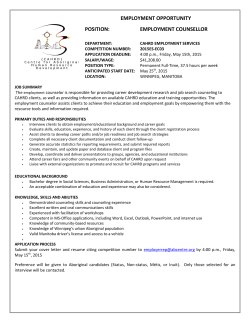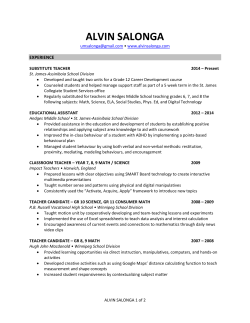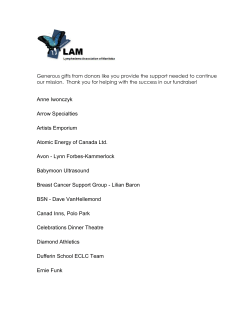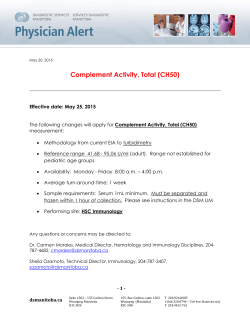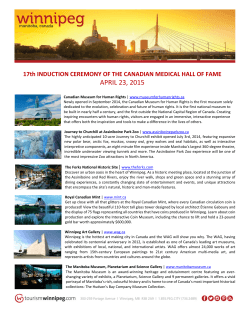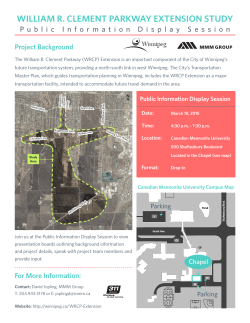
brief - Green Action Centre
Executive Policy Committee Special Meeting March 17, 2015 Re: 2015 Budget Review Thank you for the opportunity to provide comment on behalf of Green Action Centre. 1) School Travel Planning – non-regional sidewalks We were heartened to see the new line-item for non-regional sidewalks, as it will help support infrastructure improvements associated with School Travel Planning and/or Neighbourhood Travel Planning. In particular, it will assist with introducing sidewalks in areas where homeowners may not be willing to invest in the infrastructure as a local improvement. But why limit this to sidewalks only? We know from projects such as the Active School Travel Engineering Project (ASTEP) – completed this past fall and winter in a partnership between the City of Winnipeg, University of Manitoba Civil Engineering Department, and Green Action Centre – that there are many more infrastructure recommendations that require funding and work to reduce speeds around schools (beyond posted speed limits), such as chicanes, raised crosswalks and curb bump-outs that shorten the crossing distance for children and make all pedestrians more visible to motorists. Amendments / Recommendations: Expand new non-regional sidewalks budget line to also include funding for other forms of infrastructure identified through neighbourhood-based consultations and school travel planning processes. Dedicate sufficient staff and resources to work on school-zone traffic safety and children's mobility. 2) Funding transit, walking and cycling infrastructure Green Action Centre greatly welcomes the fact that the City is moving ahead with the next stage of the Southwest Transitway, and increasing funding to Active Transportation. However, we believe it is inappropriate to add to property taxes to meet transportation infrastructure needs when motor vehicles fall so far short of paying their share of societal costs in general and the costs they impose on society in particular. As we noted in the backgrounder to our letter to the Mayor and copied to Councillors last month, motorists receive a triple subsidy in Manitoba: − The current fuel tax covers less than half of road investments. − − GHGs that drive the enormous costs of climate change in Manitoba and globally are dumped without charge into the atmosphere. Without a provincial sales tax on fuel, its purchase (unlike the purchase of most other goods) makes no contribution to health, education, welfare, and government services. Property tax falls solely on homes and not on the vehicles parked beside them. When transportation fails to shoulder its share, either a greater burden is put on other revenue sources or support for public services is starved or both. Adding a special fare increase for transit riders is regressive socially, putting an extra burden on low-income and disabled non-discretionary riders. And it can drive discretionary riders back to their automobiles, when the City’s climate change, congestion reduction and road cost containment goals require a shift in the other direction. And while it's encouraging to see the budget increases ramping up over the next three years for walking and cycling infrastructure, it remains at a tiny percentage of the overall transportation budget and destines Winnipeg to have an inadequate and incomplete active transportation system for decades to come. Millennials won't wait – they want it now. For reference, please see The Winnipeg Foundation’s Youth Vital Signs Report, in which 1,860 young residents between the ages of 14 and 29 provide their thoughts on living in Winnipeg. Investing in sustainable transportation ranked in their top 5 issues (www.wpgfdn.org/YoungWinnipegConnect/YouthVitalSigns.aspx). Underlying this budget and forecast is the fact that we continue to design our city around the edges such that distance and infrequent transit service create a self-fulfilling prophecy of car dependence, which justifies road building and expansion, and the cycle continues, even though we cannot afford to maintain our existing road network. And we continue to assume that what was wanted by residents 20 years ago will continue to apply for 50 more. Yet longer distances can be readily overcome with a robust public transit system complemented by walkable and bikeable communities. To borrow a quote from US Secretary of Transportation Anthony Foxx: For too long transportation discussions “… have been focused on recreating the past. Instead, we need to focus on the trends that are shaping our future.” The 2015 Budget makes it clear that it is unsustainable with current revenue resources. There is growing support and renewed calls for more revenue sources for municipalities, but the most common ask seems to be for the Province to surrender one cent of PST to municipalities. Green Action Centre supports the City of Winnipeg in its ask for increased sources of revenue but we would also inject environmental sustainability, i.e. to focus on a fuel tax increase, tolls, and other means for drivers to pay their fair share of transportation costs. Amendments / Recommendations: Remove 5 cent additional increase to annual transit fare increase. Delay plans to extend Chief Peguis and William R Clement Parkway, widen Kenaston Ave, and building the Waverley Street underpass, and use the $600 million for transit, cycling and walking infrastructure systems instead. Accelerate discussion and implementation of development fees that reflect the full cost of infrastructure and services for new suburbs. Start discussions with the Province to explore new funding options such as a tax on registered vehicles, an increase in the fuel tax, and automated road and bridge toll billing facilitated by transponder technology. In particular, Green Action Centre supports an increase in the fuel tax targeted to support development of transit, walking and cycling systems.* While it's true that a portion of capital expenditures for streets and bridges is supported by federal and provincial fuel taxes, the provincial tax has increased only once by 2.5 cents/litre in two decades (since 1993), i.e. significantly less than inflation, despite everincreasing road expenditures and no provincial sales tax on fuel. Cars and trucks should at least pay for the streets and bridges that enable their mobility. Tap into FCM’s Green Municipal Fund (next intake April 1st). Ensure implementation of the Pedestrian and Bicycle Strategies is included in the City’s submission to the Building Canada Fund. *For comparison, note that in Vancouver and Montreal, two cities noted for their commitment to sustainability and public transportation systems, drivers pay 32.17 and 33.9 cents/litre respectively of local excise, carbon, and sales taxes, i.e. well over twice what Winnipeggers pay. And the municipalities of Metro Vancouver are about to vote on a referendum on adding another half cent to the sales tax for public transportation investments. 3) Waste diversion We are concerned not to see any investment in the 2015 Budget on concrete steps regarding waste diversion, such as the compost pick-up pilot project that was approved for 2014 but has yet to happen. Green Action Centre urges the City to move on the introduction of waste diversion programs given the Provincial proposal to ban organics in landfills starting in 2020. We also recommend serious consideration of a Pay-As-You-Throw program, which has been proven effective at diverting waste from the landfill by fostering responsibility for household waste. When Pay-As-You-Throw systems are in place, residents are encouraged to start composting in an effort to reduce their waste removal costs. In Dresden, Germany, waste generation decreased from 305 kg/capita in 1994 to 143 kg/capita in 2008 due to the implementation of an electronic Pay-AsYou-Throw system. Dresden placed barcodes on their carts, which are scanned to record and charge residents directly for the amount of waste they generate. Green Action Centre recommends that Winnipeg follow the Dresden example. Amendments / Recommendations: Include implementation of previously approved compost pick-up pilot project in 2015. Consider Pay-As-You-Throw program to divert waste from landfill. Presented by: Jackie Avent and Beth McKechnie Green Action Centre
© Copyright 2025

